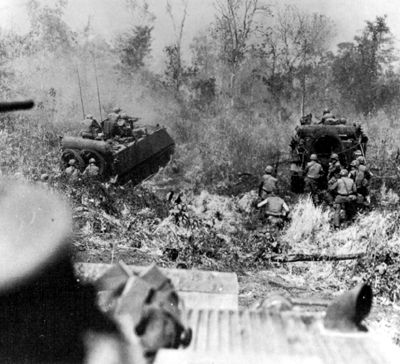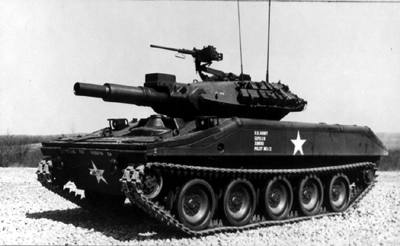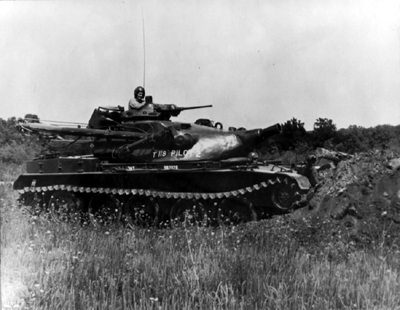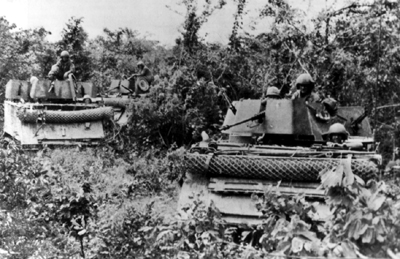-
Chapter IX:
Tam Ky
(March 1968)
- In early 1968, elements of
the 23d Infantry Division (Americal) fought a sharp, decisive battle
near the village of Tam Ky in Quang Tin Province. This action
demonstrates the use of armored cavalry in the Vietnam War. The
cavalry role was expanded, particularly in conjunction with air
scouts, and armored vehicle doctrine was modified to suit the
Vietnam environment.
A good example of the
armored cavalry in Vietnam is the operation of the 1st Squadron, 1st
Cavalry, 23d Infantry Division, at Tam Ky. The squadron included
three armored cavalry troops plus an air cavalry troop, Troop C, 7th
Squadron, 17th Cavalry. (This unit had just returned from an
operation in the Pineapple Forest west of Tam Ky.) At the time, the
division was using Lieutenant Colonel Walter C. "Mike"
Cousland's cavalry squadron as a separate maneuver battalion under
division control in his own area of operations against the 72d Local
Force Battalion, the 70th Main Force Battalion, and the V-13 and
V-15 Local Force Companies. On the evening of 3 March 1968, the
squadron, minus two cavalry platoons, was at its base camp on Hawk
Hill. The 1st Platoon of Troop A was on Hill 10, securing a sector
of Route 1; the 2d Platoon of Troop A was at Tam Ky, prepared to
assist in the defense of the province headquarters. Earlier in the
day, Captain Michael B. Prothero had assumed command of Troop C.
Little did he realize that in less than twenty-four hours he would
be commanding his troop and a rifle company against a North
Vietnamese Army regiment.
-
Captain George R. Kaczor,
the squadron's S-2 (officer in charge of the military intelligence
section), was busily studying his intelligence reports. Major Wade
E. Medbery, Jr., the S-3 (officer in charge of the operations and
training section), had issued Colonel Cousland's orders for the next
day. In the tactical operations center, all was quiet with the
exception of an occasional periodic situation report. Suddenly the
silence of the evening was broken by a loud explosion followed by a
heavy bombardment of forty-five rounds of 122-
[107]
mm. rockets and fifty rounds of mortar fire. Apparently the enemy was close by and in
considerable strength.
At first light the air
cavalry discovered the rocket-firing positions on Hill 34 to the
west of the base camp. The commanding general extended the cavalry's
area of operations to the west and attached one company of infantry.
The squadron was again to be committed as a maneuver battalion to
eliminate the enemy force that had fired on it. Troop C was ordered
to move to the west to link up with Company A, 3d Battalion, 21st
Infantry. About that time, fifteen North Vietnamese soldiers were
sighted in bunkers, and the S-3 requested an immediate air strike.
At 0938 hours, Troop C started moving toward the area of contact as
the air cavalry discovered more and more enemy positions. Some small
arms fire was being received by the aircraft, and one Huey was hit
but continued to fly. The forward air controller arrived on station
and asked the air cavalry to mark the target area. Fighters
completed the first air strike at 1100 hours.
The linkup of the infantry
company and Troop C was completed shortly after noon. Colonel
Gousland designated the cavalry troop's leader as the team commander
and gave him operational control of the air cavalry in the area of
contact. The enemy was defending from well-fortified positions.
Throughout the afternoon the cavalry-infantry team tested the
enemy's positions, pulling back periodically to let the fighters
strike. Finally, the North Vietnamese could take no more. As they
began to withdraw, the last air strikes and the artillery took a
heavy toll.
At 1920 Troop C and Company
A, 3d Battalion, 21st Infantry, moved to a night defensive position
on Hill 34-the same hill from which the enemy rockets had been fired
a few hours earlier. Hill 34 was triangular in shape, with rice
paddies and streams on two of its three sides; it was an excellent
defensive position. The field of fire over the rice paddies. was
well suited to the long-range, direct fire weapons on the tanks and
armored cavalry assault vehicles. This position guarded the Phu Xuan
River, a known enemy route, allowed observation of the enemy
position, and prevented the enemy from using the same firing data
against Hawk Hill as was used the previous night.
-
Captain Prothero closed his
units into the night location at 2012 hours. It had been a hard day
for the cavalrymen and infantrymen, but the task of preparing the
night defense was vitally important. The men learned that they were
dealing with the 3d Regiment of the 3d North Vietnamese Army
Division. The enemy had originally intended to attack Hawk Hill, but
Captain Prothero's force had thwarted his efforts. While Colonel
Cousland and his staff planned the next day's operation, the troops
started working on their defenses. The general
[108]
-
ARMORED CAVALRY ASSAULT
VEHICLES WITH RPG SCREENS ON FRONT
trace of the position
resembled the old wagon train coils of the Indian wars on the
American plains.
The armored vehicles
themselves provided protection against the enemy's small arms and
automatic weapons, but the men added a new device to protect the
vehicles against the armor-piercing B40 rocket-propelled grenade
(RPG). It was called the RPG screen. Nothing more than a section
of "cyclone" fence, it caused a shaped charge warhead to
detonate before it hit the vehicle. Each crew set up a section of
fence in front of its position, and the command element in the
center established a second screen around its vehicles. This
simple expedient saved many vehicles and bunker positions.
Fighting positions were
built between each cavalry vehicle, and some of the M60 machine
guns on the armored cavalry assault vehicles were dismounted and
positioned to provide grazing fire. Each vehicle carried three or
four rolls of concertina barbed wire. The wire was strung as an
outer barrier. Finally, four or five claymore mines were set up in
front of each armored vehicle. Listening posts were sent out, and
Team C waited for the enemy.
-
- Except for a few rounds
which landed about 100 meters outside the perimeter at 2255 hours,
the 3d North Vietnamese Army Regiment let the team alone that
night. During this lull, Colonel Cousland analyzed his situation
and prepared for the next day. He decided to send Troop C and
Company A back into the area of contact in the morning and to
attack the suspected enemy positions from the rear.
-
[109]
-

ARMORED PERSONNEL CARRIERS CLEAR THE WAY AS INFANTRY FOLLOWS
Using vehicles for cover.
Two previously planned air
strikes were made on the area shortly after first light, followed by
an artillery preparation. After an aerial resupply of ammunition,
the cavalry-infantry team moved out with air cavalry elements on
either flank. At 1305 hours the team received small arms and
automatic weapons fire at a range of fifty meters. This attack soon
developed into a heavy fight which lasted until 1830 hours, when the
unit withdrew to its night defensive positions.
On the third day Colonel
Cousland committed Troop B; Troop C, Company A of the 3d Battalion,
21st Infantry; and the air cavalry troop. The battle lasted for
several more days and resulted in 436 North Vietnamese soldiers
killed and many weapons captured. The 3d North Vietnamese Army
Regiment ceased to exist as an effective fighting force.
-
- Much of the battle of Tam Ky
was fought by the armored vehicles of the cavalry squadron. The M48
had been the standard medium tank since 1956, but its sister vehicle
in the battle, the armored cavalry
-
[110]
- assault vehicle, was
modified specifically for the cavalry squadrons in Vietnam. The old
machine gun "jeep" had lacked cross-country mobility and
armor protection for the crew. Although the M114 had been used for a
while as the scout vehicle, it was replaced with the much more
reliable armored cavalry assault vehicle (ACAV).
The ACAV was actually an
M113 personnel carrier modified by the addition of an armament
subsystem. This "A" kit consisted of hatch armor, a shield
for the commander's .50-caliber machine gun, two elbow pintle mounts
with gun shields for mounting M60 machine guns on both sides of the
M113, and a removable pintle mount on the rear as an alternate mount
for one of the M60's. The armored cavalry assault vehicle originated
with the 11th Armored Cavalry, which equipped its M1 13's with the
armament subsystems before arriving in Vietnam. The idea soon spread
through all units in Vietnam. A "B" kit armament subsystem
was also developed. It consisted of hatch armor and a shield for the
commander's .50-caliber machine gun. This kit was used on the
cavalry mortar carriers.
One of the major
innovations in the employment oŁ armor in Vietnam was the use of
the M113 as a fighting vehicle. In addition to being used to
transport troops to a battle area, it was employed like a light
tank, using the fire from mounted weapons to destroy the enemy in
close combat. The infantrymen rode on or in the carrier until
contact with the enemy was made, then they dismounted. Carriers led
the assaults, clearing paths through the underbrush as they went. In
many cases, particularly in dense foliage and mine-infested terrain,
the infantry troops did better to remain mounted and assault the
objective as the carriers detonated antipersonnel mines and booby
traps. Most of the personnel carriers, which were used as assault
vehicles, were modified as armored cavalry assault vehicles. This
technique was discussed by Major General John J. Tolson, III,
Commanding General, 1st Cavalry Division (Airmobile).
- [The APC's] didn't have the
90mm guns as did the tanks, but they had the APC's armor protection
for the personnel. Their 50 cals. were still a great help in going
into the fortified positions. Actually, on occasions, we used the
APC platoons very similar to the tank platoons.
The tanks which fought in
the battle of Tam Ky in March 1968 were M48A2's. Although their
firepower, armor, and maneuverability endeared them to the tanker,
their weight and bulk was often more than was needed. The M551
"General Sheridan" armored reconnaissance airborne assault
vehicle had been under development as "a lightweight armored
vehicle to support ground reconnaissance." In mid-1969 it began
to replace some of the tanks in the armored cavalry squadrons.
-
The relatively large 152-mm.
gun and launcher fired combustible-case conventional ammunition. It
could also fire the Shillelagh missile
[111]
-
but was not used for this
purpose in Vietnam. The gun was superior to the 90-mm. tank gun
against both bunkers and personnel, and its canister round was
excellent to open up bamboo thickets. A disadvantage of the M551 was
its limited ability to "bust" through dense jungle. The
main battle tank was greatly superior in this respect.
-
-
In phasing in the General
Sheridans, the 11th Armored Cavalry was issued three Sheridans for
two of the ACAV's in the reconnaissance platoon. Thus, the cavalry
troop lost none of its jungle-busting ability and greatly increased
its firepower. In the division's cavalry squadrons, however, tanks
had been assigned to each cavalry platoon instead of to a separate
tank troop. The Sheridan was substituted on a one-for-one basis for
M48 tanks, resulting in a loss of jungle-busting ability.
-
-
An excellent example of the
Sheridan's fighting capabilities occurred on 11 March 1969, almost a
year after the battle of Tam Ky, when Captain John W. Wells, III,
moved Troop A, 3d Squadron, 4th Cavalry, into a night defensive
position. He was located at a road junction west of the Ben Cui
Rubber Plantation along a known enemy infiltration route. Judging
from the results, the enemy did not realize the unit was there. All
of the Sheridans in the perimeter were equipped with night
observation devices. One of the crews detected a group of enemy
troops in an open field, moving directly toward it. Captain Wells
instructed the crew to hold its fire and load its canisters. He then
moved to the Sheridan to observe the enemy movement personally. As
the enemy came closer, the large number of radios indicated that
this unit was the command group of a North Vietnamese battalion.
-
-
When Captain Wells gave the
order to fire, the first round eliminated the whole command group.
Having lost its leadership, the enemy soldiers panicked and milled
around in the area. In a few minutes the enemy lost forty-two men
killed in action and one prisoner of war as compared to two U.S.
soldiers wounded. This encounter demonstrated that the Sheridan was
a significant combat weapon even during hours of darkness.
-
Frequently, tanks from the
division tank battalion were attached to the cavalry squadron when
additional jungle-busting power was needed. Another solution to the
problem was to attach one or two combat engineer vehicles (CEV),
M728, to the squadron for certain operations. The need for a combat
engineer vehicle first arose during World War II in the hedgerows of
Normandy, when bulldozer blades were fitted to tanks, but it was not
until Vietnam that such a vehicle arrived on the battlefield. The
M728 had been designed to support armor and mechanized units through
fire-swept areas and to accomplish a broad range of combat
engineering tasks. It was assigned to the division engineer
battalions. The combat engineer vehicle is a
[112]
-

"GENERAL SHERIDAN" ARMORED RECONNAISSANCE AIRBORNE ASSAULT
VEHICLE
-
-
modified M60 tank with a
bulldozer blade, a turret-mounted A-frame and winch, and a 165-mm.
demolition gun. With its armor protection, this vehicle could move
forward under enemy fire to destroy obstacles and fortifications
with its demolition gun, clear obstacles with its bulldozer blade,
and use the A-frame to lift equipment or place and recover bridges.
-
In the 23d Infantry Division
(Americal), the combat engineer vehicle repeatedly proved to be a
valuable asset to engineer and infantry operations. The vehicle was
used in fire support, base security, counterambush fire, direct
assault of fortified positions, and limited reconnaissance by fire.
It even spearheaded an infantry-cavalry charge in the village of
Tap
An Bac on 19 June 1969, when division elements came to the defense
of two bulldozers and a work party from the 26th Engineer Battalion.
The day-long fight was won in the final assault.
The M48 tank saw combat for
the first time in Vietnam. For the most part, tanks were part of a
tank-infantry or cavalry team and conventional tactics were used.
Commanders did, however, seek better ways to use their limited armor
assets.
-
In December 1966, the 2d
Battalion, 34th Armor, was assigned to secure the route from Tay
Ninh to Tri Tam, where small groups of Viet Cong had been
successfully mining the road. The battalion commander chose to use
the "thunder run" technique to offset this enemy action.
During the hours of darkness, a tank company or platoon "ran
[113]

COMBAT ENGINEER
VEHICLE
-
-
the road" two or three
times at irregular intervals. It fired canisters and .50-caliber and
7.62-mm. machine guns at likely enemy locations on both sides of the
road. After three nights, mining incidents stopped, and the first Chieu
Hoi rapier surrendered. He attributed his action to the thunder
runs. This technique was used by most of the tank units in Vietnam.
-
-
Lieutenant General William
R. Peers, Commanding General, I Field Force, Vietnam, made the
following comment about tanks.
-
-
In the southern coastal
provinces .. the monsoon rains are sufficiently light that
normally tanks can operate the year round. Here they proved most
productive. For example, the provisional U.S. tank platoon in the
Phan Thiet area has added more stability to the area than any other
single element. Having been successful in blasting the enemy out of
their positions on numerous occasions, they have given a high degree
of confidence to the ARVN, the RF/PF, and the local population. On
the other hand, they are greatly feared by the enemy to the extent
that he has tried on numerous occasions, but without success, to
destroy or otherwise eliminate them.
-
The shock effect of even a
single tank in guerrilla warfare was apparent in Vietnam. Lieutenant
Colonel Ronald J. Fairfield, Commanding Officer, 1st Battalion, 69th
Armor, stated, "The NVA/VC have shown a reluctance to engage
tanks where they can be avoided."' A
[114]
-
year later, Lieutenant
Colonel Paul S. Williams, Jr., while commanding the same battalion,
said: "Captured documents and interrogation reports disclose
that the enemy is afraid of tanks. We feel what he really fears is
the cannister round and its effect. This [feeling] has been
justified, to a degree, by the absence of contact when tank and
infantry units move together." Obviously, the enemy did fight
armored and cavalry units, but usually he either was put in a
position where he had to fight or felt that he possessed sufficient
strength to defeat the American force. Colonel Donn A. Starry, one
of the commanders of the 11th Armored Cavalry, stated, "A
cavalry troop well handled was generally capable of fighting
anything the NVA could field, at least until additional cavalry and
firepower could be mustered."
-
An example of the cavalry's
shock action occurred when the U.S. 1st Infantry Division staged the
battle of Minh Thanh road. The division leaked word that it planned
to move engineer equipment and supply vehicles between Minh Thanh
and An Loc on 9 July 1966. Actually, two armored cavalry troops and
one infantry company were sent along the route, and other combat and
combat support forces were positioned to assist. When the 272d North
Vietnamese Army Regiment spotted the cavalry force from its ambush
positions, it attacked. By the time the smoke cleared the enemy
regiment had lost 239 dead on the battlefield, 89 captured, and an
estimated 304 killed but not visible in the area. The regiment was
probably reduced to less than 50 percent of its strength.
-
Some of the findings of the
official "Evaluation of Mechanized and Armor Combat Operations
in Vietnam (MACOV)" summarize the effectiveness of armored
cavalry units.
-
-
Armored cavalry units were
employed in roles previously assigned to tank and infantry maneuver
battalions to addition to the traditional reconnaissance, security,
and economy of force roles. This change has evolved due to the
nature of the enemy in Vietnam, the concept of area war and the
balanced combined arms structure of the armored cavalry squadron.
There are definitive battlefields in the traditional sense, the
enemy has a propensity for avoiding contact by moving in small
groups-massing only for short term offensive actions.
-
-
Armored
cavalry squadrons have proven effective not only as a force to find
and fix the enemy, but also as an aggressive offensive force. The
balanced combined arms of structure and inherent capability for
quick response and extended independent action have made it possible
to employ the armored cavalry squadron as a well-balanced maneuver
battalion.
-
The most important materiel
innovations associated with mechanized warfare in Vietnam were the
combat
-
-
engineer vehicles, the M551 General Sheridans, and the
modifications of the M113 personnel carrier. These vehicles were
integrated with new techniques, such as airmobile tactics, secure
communications, and night vision equipment, and proved enormously
effective. The rocket-propelled gren-
[115]
-
ade screen was one of the
most widely used innovations of the war. Cyclone fence could be
found at virtually every U.S. installation in Vietnam. The concept
of detonating enemy rocket-propelled grenades before they hit the
target was sound, and the adaptation of existing materiel for this
use was ingenious.
-
-
The use of the M113 in a
tank-like role will interest the military theorists for years. The
M113 brought to the Vietnam battlefield the shock, firepower, and
mobility that are characteristic of tank warfare. The terrain was
less than ideal for tanks; the enemy's forces included no
significant armor formations. Given these conditions, it is not
surprising that the M113 was often used as a tank.
-
-
The development of
jungle-busting techniques and thunder runs was the logical outgrowth
of mechanized forces in the Vietnam environment. Every combat
commander in Vietnam faced the problems of jungle warfare and enemy
mines. Jungle-busting was the only way to exploit mechanized
mobility in the forests, and the firepower and shock action of an
M113 or a General Sheridan was invaluable to a force in an occupied
enemy base camp.
-
-
U.S. armor and mechanized
formations made a significant contribution to the allied effort in
Vietnam. The armor soldier with modern equipment, training, and
leadership proved his effectiveness and gave the Viet Cong and North
Vietnamese Army ample reason to avoid tanks where they could.[116]
- page created 15 December 2001
Previous Chapter
Next Chapter
Return to the Table of Contents



